Contenido
El correo electrónico sigue siendo una de las plataformas de comunicación más potentes para llegar a su público e interactuar con él. Sin embargo, enviar un mensaje general a todos los miembros de la lista no solo es anticuado, sino también ineficaz.
Saltarse la segmentación es como gritar "¡Eh, tú!" en una sala llena de gente y esperar que se gire la persona adecuada. Si bien es posible que captes la atención de alguien, es poco probable que sea la adecuada.
Su audiencia está formada por individuos con intereses, necesidades y comportamientos diversos. Su estrategia de correo electrónico debe reflejar esta diversidad para conectar realmente con cada suscriptor.
En este artículo exploraremos la cuestión: ¿Por qué es importante la segmentación en marketing por correo electrónico con respuestas sobre cómo puede transformar sus campañas.
Compartiremos 25 estrategias probadas que le ayudarán a implementar la segmentación de forma efectiva, aumentando sus tasas de apertura, generando más conversiones y, en última instancia, haciendo que sus correos electrónicos sean más relevantes e impactantes para sus suscriptores.
¿Por qué es importante la segmentación en el marketing por correo electrónico?
Conseguir que alguien se suscriba a su lista de correo electrónico es una victoria, pero es sólo el principio de la conversación.
Puede que sus suscriptores se hayan apuntado para saber más sobre lo que usted ofrece, pero ahí acaban las similitudes. Cada persona de tu lista tiene intereses, necesidades y motivaciones diferentes.
Aquí es donde la segmentación se convierte en su arma secreta.
Si divide su lista en grupos específicos en función de intereses, comportamientos y motivos por los que se suscribió, podrá crear mensajes de correo electrónico que parezcan escritos exclusivamente para ellos.
Los profesionales del marketing experimentan un aumento de los ingresos de hasta un 760% gracias a las campañas segmentadas. - Monitor de campaña
Cuando sus correos electrónicos hablan directamente de lo que les interesa a sus suscriptores, no sólo está enviando mensajes, sino que está estableciendo conexiones. ¿Y esas conexiones? Llevan a más abre, más clicsy más acciones.
25 estrategias de segmentación del correo electrónico para su próxima campaña
Para tener un impacto real con su marketing por correo electrónicoSi su mensaje no es el mismo para todos, tiene que ir más allá de un enfoque único. Tus suscriptores no son todos iguales, así que tus correos electrónicos tampoco deberían serlo.
Al segmentar su lista de correo electrónico, puede enviar mensajes más relevantes y significativos, lo que aumenta las posibilidades de que su audiencia se comprometa con su contenido.
La segmentación le permite diríjase a sus abonados en función de factores clave como el comportamiento, los datos demográficos, la ubicación y el punto en el que se encuentran en su recorrido con la marca.
Este enfoque específico garantiza que sus mensajes de correo electrónico no sólo se envíen, sino que se vean, se entiendan y se actúe en consecuencia.
Ahora vamos a explorar 25 estrategias de segmentación que pueden ayudarle a adaptar sus campañas de forma más eficaz y a obtener mejores resultados.
Segmentación por comportamiento del correo electrónico
La segmentación por comportamiento consiste en comprender cómo interactúa su público con su contenido, ya sea haciendo clic en enlaces de afiliados, interactuando con sus mensajes de correo electrónico o navegando por su sitio web.
- Clics en enlaces de afiliados: Haga un seguimiento de los enlaces de afiliación en los que sus suscriptores hacen clic con más frecuencia. Estos datos pueden ayudarte a identificar sus preferencias de productos e intereses, lo que te permitirá enviar correos electrónicos específicos que promocionen productos similares o complementarios, aumentar la probabilidad de venta.
- Compromiso por correo electrónico: Supervise cómo interactúa su público con sus correos electrónicos actuales: si los abren, haga clic en los enlaces¿o ignorarlos? Al segmentar en función de este comportamiento, puede recompensar a sus suscriptores más comprometidos con ofertas exclusivas o acceso anticipado a nuevos productos de afiliación, lo que les mantendrá interesados y fieles.
- Interacción de contenidos: Preste atención a qué entradas de blog, artículos u otros contenidos de su sitio son conseguir el mayor tráfico. Si un suscriptor visita con frecuencia contenidos sobre un nicho específico, puede adaptar sus promociones por correo electrónico para destacar los productos afiliados relacionados con ese interés.
- Activadores de eventos: Las acciones específicas, como hacer clic en un enlace de afiliado pero no realizar una compra, pueden desencadenar correos electrónicos de seguimiento. Estos mensajes específicos pueden incluir incentivos adicionales o recomendaciones de productos similares para animar al suscriptor a volver y completar la compra.
- Actualizaciones de productos: Si promociona productos que se actualizan con regularidad o tienen nuevas versiones, mantenga informada a su audiencia. Segmenta tu lista para dirigirte a quienes hayan mostrado interés por esos productos y envíales actualizaciones o promociones de las últimas ofertas.
Consejo: Descubra qué impulsa los clics con la información sobre comportamiento de PrettyLinks
Supervise sus enlaces de afiliado en PrettyLinks para ver qué productos reciben más atención y de quién. A continuación, crea una campaña de correo electrónico para amplificar aún más ese interés.
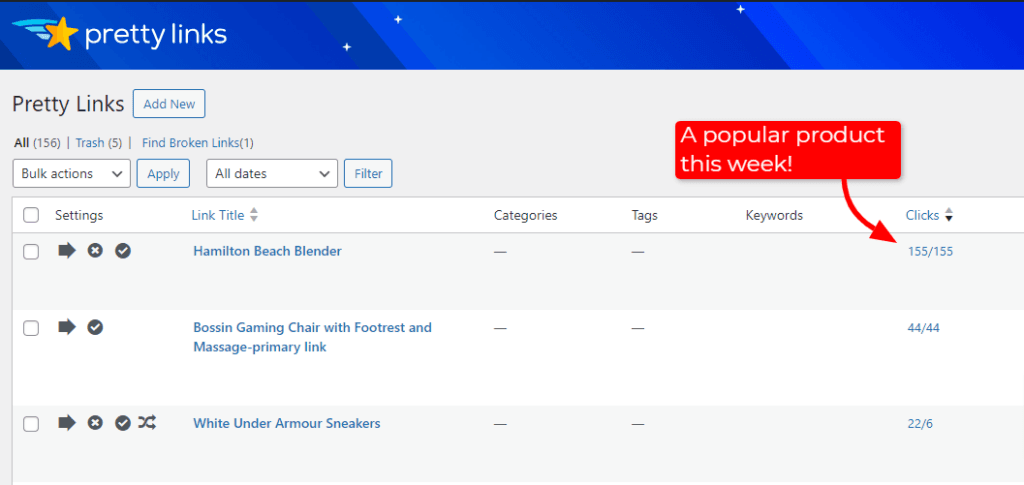
Segmentación demográfica
La segmentación demográfica le permite desglosar su lista de correo electrónico en función de factores clave como la edad, el sexo, la ocupación y el nivel educativo.
- La edad: Los distintos grupos de edad tienen comportamientos de compra y preferencias de contenido únicos. Al segmentar por edad, puede enviar promociones y mensajes que se ajusten a la etapa de la vida en la que se encuentran. descuentos para estudiantesproductos orientados a la familia o servicios de planificación de la jubilación.
- Género: Los hombres y las mujeres suelen responder de forma diferente a estrategias de marketing. Al segmentar por sexos, puede elaborar campañas que tengan en cuenta estas diferencias, como la promoción de productos específicos para cada sexo o destacar aspectos de su servicio que atraigan más a uno de los sexos, lo que aumentará la participación y las ventas.
- Ocupación: Entender la profesión de sus suscriptores le permite adaptar contenidos que respondan directamente a sus necesidades laborales. Por ejemplo, puede ofrecer consejos de promoción profesional a los profesionales o a los empleados. promover soluciones empresariales entre los empresarios, haciendo que sus correos electrónicos sean más relevantes y valiosos.
- Nivel educativo: Los suscriptores con diferentes niveles educativos pueden tener distintos niveles de familiaridad con su producto o servicio. Al segmentar por nivel educativo, puede ajustar la complejidad de su contenido, garantizando que sus correos electrónicos sean accesibles y fáciles de entender para todos.
Consejo: Recopilar datos demográficos para segmentar el correo electrónico a través de las redes sociales
Las redes sociales son perfectas para poner cara y personalidad a tu público. Utiliza publicaciones interactivas, como encuestas, concursos o debates, para interactuar con tus seguidores.
A continuación, examine quién está interactuando y explore sus perfiles sociales para obtener información sobre sus datos demográficos.
Toma este post de Facebook de BuzzFeed Quiz por ejemplo, que pide a sus seguidores que comenten su opinión sobre el estilo "mom jeans".
Esta pregunta no sólo despierta el interés de los usuarios, sino que también puede proporcionar sutilmente información sobre los grupos de edad de tus seguidores en función de sus respuestas.
Mediante encuestas lúdicas como ésta, puede recopilar información valiosa y crear campañas de correo electrónico específicas que se ajusten a las preferencias y experiencias de cada grupo de edad.
Segmentación geográfica
Llegar a su público allí donde vive -literalmente- puede tener un impacto significativo en la eficacia de sus campañas de correo electrónico. La segmentación geográfica le permite adaptar sus correos electrónicos en función de la ubicación de sus suscriptores, asegurándose de que sus mensajes resuenan en diferentes regiones.
- País o región: Cada región tiene sus propias preferencias culturales y dinámicas de mercado. Al segmentar tu lista por países o regiones, puedes crear contenidos que tengan resonancia entre el público local, ya sea destacando productos específicos de la región, ofertas de temporada o mensajes culturalmente relevantes.
- Diferencias horarias: El momento oportuno lo es todo en marketing por correo electrónico. Si tiene en cuenta las zonas horarias de sus suscriptores, puede asegurarse de que sus mensajes lleguen a sus bandejas de entrada en los momentos más oportunos. Tanto si se trata de una oferta a primera hora de la mañana como de una venta a última hora de la noche, programar tus correos electrónicos para que coincidan con las horas de mayor actividad puede aumentar significativamente las tasas de apertura y de clics.
- Patrones meteorológicos locales: El tiempo influye mucho en el comportamiento de los consumidores. Si tiene en cuenta las condiciones meteorológicas locales, puede promocionar productos o servicios de interés inmediato. Por ejemplo, si en una zona determinada hay una ola de calor, destacar los productos de refrigeración o los artículos esenciales para el verano puede suscitar un interés y unas ventas más inmediatos.
Consejo: Dirija a los suscriptores a productos específicos de su región con enlaces geoespecíficos.
Con los georredireccionamientos de PrettyLinks, puede crear enlaces basados en la ubicación que se ajustan a la ubicación de sus suscriptores de correo electrónico.
Por ejemplo, puede utilizar un término de producto amplio como "ropa olímpica" en su correo electrónico. PrettyLinks dirigirá entonces a los suscriptores estadounidenses a la ropa del equipo de EE.UU., mientras que los suscriptores franceses verán tus recomendaciones de productos del equipo de Francia.
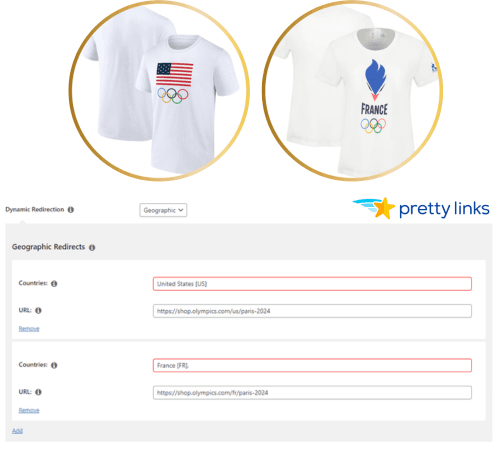
Segmentación tecnológica
La segmentación tecnológica le permite personalizar sus correos electrónicos en función de los dispositivos, sistemas operativos y navegadores específicos que utilizan sus suscriptores, garantizando que sus contenidos son accesibles y atractivos.
- Uso de dispositivos: Tanto si tus suscriptores consultan el correo electrónico en sus teléfonos como en un ordenador de sobremesa, conocer sus preferencias de dispositivo te permite diseñar contenidos que se adapten perfectamente al tamaño de su pantalla. Los usuarios de móviles apreciarán los correos electrónicos concisos y visualmente atractivos, mientras que los usuarios de ordenadores de sobremesa estarán más interesados en contenidos más detallados.
- Sistemas operativos: Cada sistema operativo, ya sea Windows, macOS, iOS o Android, tiene sus propias características. Si adaptas tu contenido a los sistemas operativos que utiliza tu audiencia, podrás ofrecer consejos, trucos o recomendaciones de productos relevantes que encajen con su configuración.
- Preferencia de navegador: Los distintos navegadores pueden mostrar el contenido de diferentes maneras. Saber si su público utiliza principalmente Chrome, Safari o Firefox le permite optimizar sus correos electrónicos para esos navegadores, garantizando una visualización fluida, experiencia de usuario coherente sin ningún problema frustrante de visualización.
Consejo: Mejore la experiencia del usuario con enlaces orientados a dispositivos y navegadores
Aproveche Redireccionamientos basados en la tecnología PrettyLinks en sus correos electrónicos para mejorar la experiencia del usuario.
Por ejemplo, puede dirigir automáticamente a los suscriptores que abran sus correos electrónicos en sus teléfonos a páginas optimizadas para móviles. Del mismo modo, puedes redirigir a los usuarios de Firefox a una página optimizada específicamente para su navegador, garantizando la mejor visualización y rendimiento posibles.
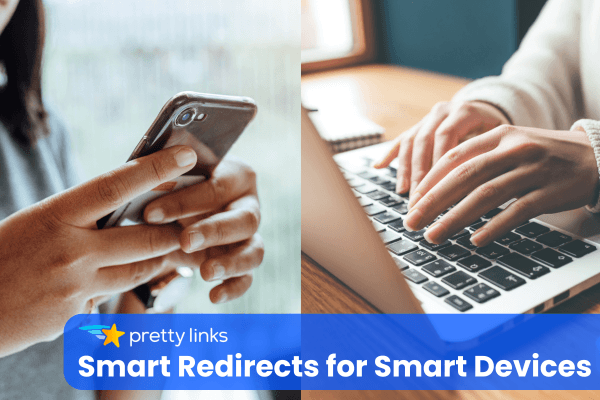
Segmentación psicográfica
La segmentación psicográfica requiere marketing por correo electrónico a un nivel más profundo centrándose en las características psicológicas de sus abonados. Este enfoque va más allá de los datos demográficos básicos, permitiéndole conectar con su audiencia a un nivel más personal y emocionalmente resonante.
- Intereses y aficiones: Conocer los intereses de sus suscriptores puede ayudarle a elaborar mensajes que capten su atención. Por ejemplo, si a alguien le gusta el senderismo, un asunto como "¿Te gusta el senderismo? Echa un vistazo a nuestro último equipo diseñado para aventuras al aire libre" es probable que llame su atención y conduzca a mayores tasas de clics.
- Elecciones de estilo de vida: Adaptar el contenido al estilo de vida de tus suscriptores puede hacer que tus correos electrónicos sean más relevantes. Ya sean entusiastas del fitness, vegetarianos o consumidores de lujo, alinear tus mensajes con su estilo de vida te ayuda a conectar a un nivel que resuena con su vida diaria.
- Valores y actitudes: Segmentar tu audiencia en función de sus valores compartidos te permite crear contenidos que hablen directamente de lo que más les importa. Ya sea destacando prácticas sostenibles, promoviendo causas sociales o mostrando tecnología innovadora, alinear sus correos electrónicos con las creencias fundamentales de sus suscriptores puede refuerce su relación y fomente la fidelidad a la marca.
Consejo: Descubra qué motiva a su audiencia con las encuestas de Jotform
Utilice una herramienta como Jotform para captar detalles psicográficos sobre sus usuarios, como sus intereses, valores y opciones de estilo de vida.
Por ejemplo, invite a los visitantes a completar un rápido estudio del producto que explora cómo sus intereses y necesidades determinan sus hábitos de compra.
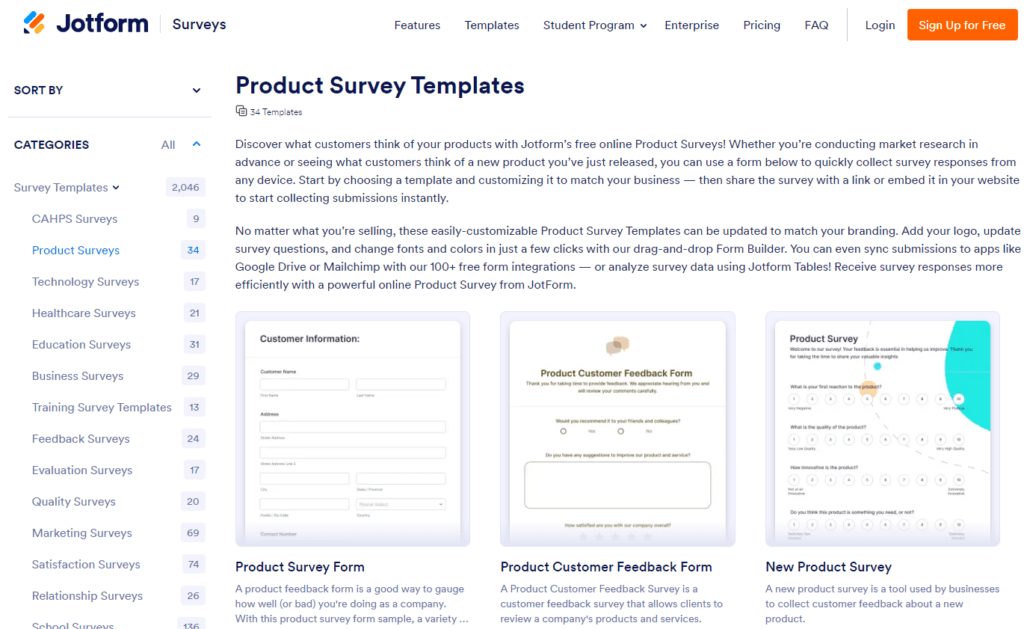
Esta información le permite segmentar sus correos electrónicos de productos de afiliación con precisión, asegurándose de que sus ofertas se ajustan perfectamente a lo que cada grupo realmente desea.
Segmentación del recorrido del cliente
La segmentación del recorrido del cliente le permite adaptar sus correos electrónicos en función del punto en el que se encuentra cada suscriptor en su relación con su marca. En atender sus necesidades específicas en cada etapa - tanto si acaban de conocerle como si llevan años con usted, puede crear interacciones más eficaces y significativas.
- Nuevos abonados: Una serie de correos electrónicos de bienvenida puede marcar la pauta para quienes acaban de empezar a conocer su marca. Presente su marca, destaque los productos o servicios clave y dígales qué pueden esperar de futuras comunicaciones. Esto ayuda a construir una base sólida para su relación.
- Usuarios activos: Estos suscriptores están comprometidos e interesados, por lo que es el momento perfecto para ofrecerles contenidos valiosos que les ayuden a tomar decisiones informadas. Ya se trate de guías de productos, estudios de casos o artículos prácticos, ofrecer información relevante les mantiene comprometidos y les hace avanzar en su viaje.
- En riesgo de abandono (fase de decisión): Algunos suscriptores pueden estar a punto de perder interés o alejarse. Identifique a los que no han interactuado con sus correos electrónicos o realizado una compra recientemente y envíeles mensajes específicos con ofertas especiales, recordatorios o incentivos para reavivar su interés y mantenerlos conectados a su marca.
- Clientes morosos: Para los que se han quedado fuera del radar, la clave es volver a conectar. Dirígete a estos suscriptores con ofertas exclusivas o actualizaciones de nuevos productos para recordarles lo que se están perdiendo y animarles a volver a conectar con tu marca.
Más información en >> Guía para principiantes sobre embudos de conversión (y cómo optimizar el suyo)
Consejo: Convierta a los visitantes en suscriptores con los formularios de registro de OptinMonster
Haga crecer su lista de correo electrónico sin esfuerzo como lo hizo Adam Enfroy con OptinMonstercrear ventanas emergentes o formularios incrustados dirigidos a los nuevos visitantes.
Dato curioso: el ejemplo de opt-in de Adam anterior generó más de 11.000 nuevos suscriptores a su lista ¡en sólo 1 año!
Puede hacer lo mismo ofrecer un valioso incentivocomo un libro electrónico gratuito o acceso a contenidos exclusivos, para animar a los visitantes del sitio a suscribirse a su lista de correo electrónico.
Fechas especiales
Reconocer y celebrar fechas especiales en la vida de sus suscriptores es una forma eficaz de añadir un toque personal a sus campañas de correo electrónico. La segmentación de fechas especiales le permite adaptar sus mensajes a estos momentos importantes, mostrando a sus suscriptores que los valora y aprecia.
- Cumpleaños: Un cumpleaños es una oportunidad perfecta para hacer que sus suscriptores se sientan especiales. Envíe correos electrónicos personalizados el día de su cumpleaños con ofertas exclusivas, descuentos o regalos para celebrar su día. Este sencillo gesto puede crear una conexión emocional positiva y animarles a comprométase con su marca.
- Aniversarios de suscripción: Otra forma de mostrar agradecimiento es celebrar el aniversario de la fecha en que un suscriptor se unió a su lista o realizó su primera compra. Reconozca este hito ofreciéndoles recompensas especiales, descuentos o contenido exclusivo. Es una forma estupenda de agradecerles su fidelidad y animarles a seguir participando.
- Desencadenantes estacionales o relacionados con las fiestas: Alinee sus campañas de correo electrónico con las principales festividades y las temporadas pueden crear contenido oportuno y relevante que resuene entre sus suscriptores. Ya se trate de ofertas navideñas, consejos de temporada o promociones temáticas, estas campañas pueden aprovechar el espíritu festivo y aumentar la participación.
Consejo: Convierta la recogida de datos en un placer con formularios y correos electrónicos temáticos
Crear una comunidad en líneaya sea gratuita o de pago, es una de las mejores maneras de comprender realmente a su público y fomentar las conexiones.
Durante el proceso de inscripción, puede recopilar información valiosa sobre sus afiliados, lo que le permite adaptar una experiencia de afiliación personalizada para cada persona.
Otro punto fuerte de OptinMonster es su capacidad de crear campos de formulario personalizados para recopilar información específica de cada persona que rellena el formulario, como su cumpleaños, aniversarios e intereses.
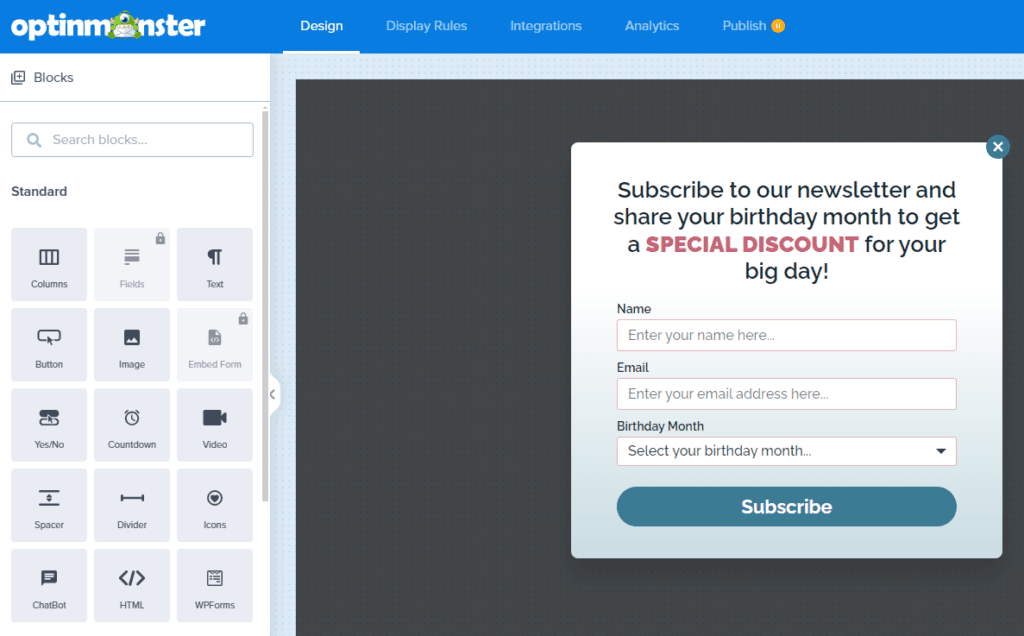
Si coloca estratégicamente estos formularios en páginas con mucho tráfico o en momentos clave del recorrido del usuario, podrá convertir de forma eficaz a más visitantes en suscriptores comprometidos.
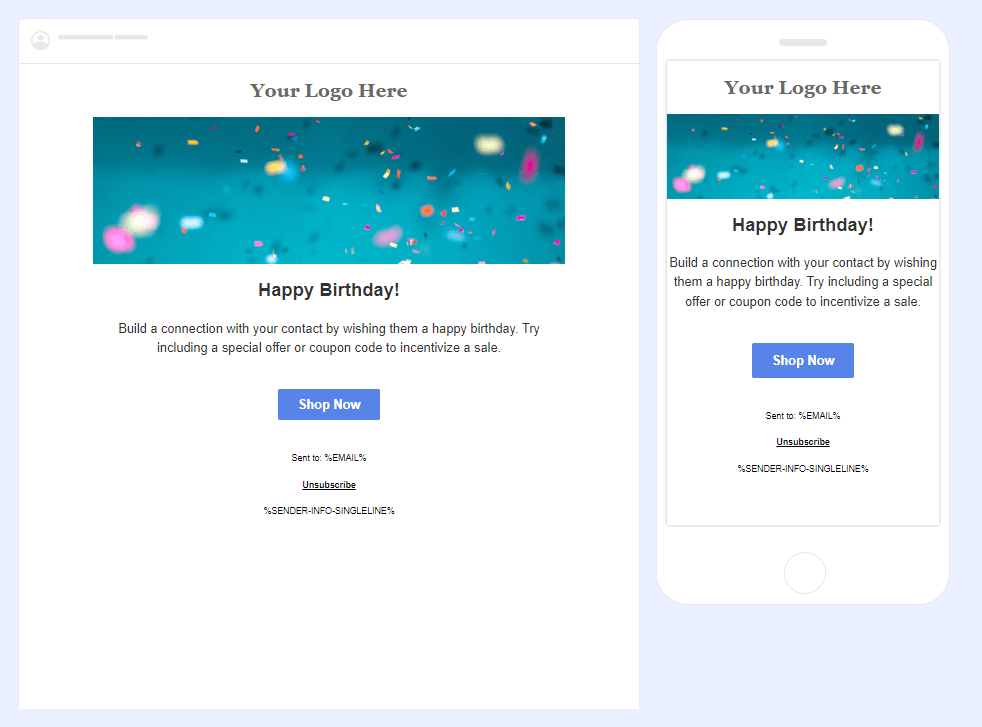
Además, muchas plataformas de marketing por correo electrónico, como ActiveCampaign, también ofrecen plantillas prefabricadas, incluidos diseños con temas navideños, que facilitan y agilizan el lanzamiento de campañas festivas segmentadas.
Cómo implementar estas estrategias de segmentación de correo electrónico (herramientas adicionales para probar)
A lo largo de este post, hemos mencionado varias herramientas de segmentación útiles. Pero aquí tienes una lista de referencia rápida con aún más opciones que te ayudarán a recopilar datos de los usuarios, realizar un seguimiento de su comportamiento y enviar correos electrónicos bien segmentados.
1. Recopilar y analizar los datos de los abonados
Recopilar y analizar los datos de los abonados es fundamental para comprender a su público y diseñar campañas que conecten de verdad.
Las herramientas de CRM facilitan este proceso ayudándole a recopilar información detallada, como datos demográficos, preferencias y comportamientos, y a utilizar esos datos para personalizar sus campañas de marketing por correo electrónico.
Empezando por formularios o encuestas personalizados, puede obtener información esencial sobre sus suscriptores desde el mismo momento en que llegan a su sitio web.
Una vez recopilados estos datos, las herramientas de CRM le ayudan a analizarlos y organizarlos, lo que facilita la adaptación de sus mensajes y ofertas a cada suscriptor.
Nuestras mejores herramientas CRM:
- HubSpot CRM: Agiliza la recopilación de datos y automatiza las campañas de marketing personalizadas para mantener el interés de su público.
- Salesforce: Ofrece información detallada a través de análisis avanzados, que le ayudan a ajustar sus estrategias de marketing basándose en los datos de los abonados.
- Cápsula: Organiza la información y las interacciones de los clientes en un solo lugar, lo que le permite segmentar fácilmente los contactos y ofrecer campañas personalizadas que resuenen con su audiencia.
2. Seguimiento del comportamiento de los usuarios
Comprender cómo interactúan los suscriptores con su contenido es esencial para elaborar estrategias de marketing por correo electrónico que realmente tengan eco. El seguimiento de sus interacciones -ya sea cómo navegan por tu sitio web o en qué enlaces hacen clic- te permite obtener información valiosa sobre sus intereses y preferencias.
El seguimiento del comportamiento de los suscriptores también le ayuda a identificar patrones, como qué temas de contenido generan más interés o qué productos se ven con frecuencia pero no se compran.
Con estos datos, puede perfeccionar sus mensajes, plazos y ofertas para que se ajusten más a lo que le interesa a su público. Este nivel de personalización mejora la experiencia del usuario y aumenta la probabilidad de conversiones.
Nuestras mejores herramientas de seguimiento de usuarios:
- Google Analytics: Una plataforma completa que ofrece información detallada sobre el comportamiento de los usuarios en su sitio web. Google Analytics realiza un seguimiento de todo, desde la procedencia de los visitantes hasta lo que hacen en su sitio, lo que le ofrece una imagen clara de cómo interactúan con su contenido. Esta información es muy valiosa para optimizar su sitio web y sus campañas de correo electrónico con el fin de satisfacer mejor las necesidades de los suscriptores.
- ExactMetrics: Una herramienta fácil de usar que se integra con Google Analytics, ExactMetrics proporciona informes detallados sobre el tráfico del sitio web y el comportamiento de los usuarios. Le ayuda a comprender cómo interactúan los suscriptores con su contenido, desde las páginas que visitan hasta los enlaces en los que hacen clic, lo que le permite adaptar sus estrategias de marketing en función de los datos en tiempo real.
- PrettyLinks: Esta herramienta le permite rastrear y controlar los clics en sus enlaces de afiliado, proporcionando información sobre qué productos y ofertas resuenan más con su audiencia. Al saber qué enlaces generan más interés, puedes ajustar tus promociones y tu estrategia de contenidos para centrarte en aquello a lo que tus suscriptores de correo electrónico tienen más probabilidades de responder.
3. Elija el sistema de marketing por correo electrónico adecuado
La última pieza del rompecabezas del marketing por correo electrónico es seleccionar el sistema adecuado para crear y enviar correos electrónicos segmentados. Una potente plataforma de email marketing te permitirá ofrecer contenido personalizado a cada segmento de tu audiencia, garantizando que tus mensajes resuenen con sus intereses y necesidades específicas.
A la hora de elegir una plataforma de marketing por correo electrónico, tenga en cuenta las siguientes características:
- Segmentación avanzada: La capacidad de segmentar su audiencia en función de diversos criterios, como los datos demográficos, el comportamiento, el historial de compras o el nivel de compromiso, es esencial para ofrecer contenidos pertinentes.
- Capacidades de automatización: Busque plataformas que le permitan automatizar sus campañas en función de desencadenantes como acciones de los usuarios, fechas o condiciones específicas. Esto puede ahorrar tiempo y garantizar que tus suscriptores reciban correos electrónicos oportunos y relevantes sin intervención manual.
- Análisis e informes: Los análisis detallados le ayudan a comprender el rendimiento de sus campañas en los distintos segmentos. Podrás ver qué mensajes de correo electrónico generan más interacción y conversiones, lo que te permitirá perfeccionar tu estrategia a lo largo del tiempo.
Nuestros mejores sistemas de marketing por correo electrónico:
- Keap: Keap, una plataforma popular y fácil de usar, ofrece sólidas funciones de segmentación y automatización. Permite crear flujos de trabajo complejos y automatizados que ofrecen contenidos personalizados en función del comportamiento del suscriptor. Gracias a sus avanzadas herramientas de generación de informes, puedes hacer un seguimiento del éxito de cada segmento y ajustar tu estrategia según sea necesario.
- ConvertKit: Ideal para creadores y pequeñas empresas, ConvertKit destaca por su sencillez y facilidad de uso, al tiempo que ofrece potentes opciones de segmentación y automatización. Permite etiquetar a los suscriptores en función de sus acciones, lo que facilita el envío de correos electrónicos dirigidos a intereses o comportamientos específicos. ConvertKit también proporciona herramientas de automatización visual que le permiten diseñar flujos de trabajo complejos con facilidad.
- ActiveCampaign: Conocido por sus avanzadas capacidades de automatización, ActiveCampaign proporciona opciones de segmentación profunda, lo que le permite crear campañas de correo electrónico altamente personalizadas. También se integra con una amplia gama de herramientas de CRM, lo que le permite combinar el marketing por correo electrónico con la gestión de las relaciones con los clientes para una experiencia perfecta. Las sólidas funciones de análisis y pruebas divididas de ActiveCampaign le ayudan a ajustar sus campañas para obtener el máximo impacto.
Combinando estas herramientas, podrá aplicar estrategias de segmentación del correo electrónico que respondan directamente a las necesidades e intereses de su público, lo que se traducirá en un mayor compromiso, más conversiones y relaciones más sólidas con los clientes.
Conclusión
La eficacia del marketing por correo electrónico depende de su capacidad para conectar con su público de forma significativa, y la segmentación es la clave para establecer esa conexión.
Si conoce las características únicas de sus suscriptores -ya sea su comportamiento, sus datos demográficos, su ubicación geográfica, sus preferencias tecnológicas, sus rasgos psicográficos o su etapa en el recorrido del cliente-, podrá crear campañas de correo electrónico muy específicas y personalizadas.
Estas estrategias garantizan que sus mensajes resuenen en su audiencia, lo que conduce a un mayor compromiso, relaciones más sólidas y, en última instancia, mejores resultados empresariales.
Así que.., ¿por qué es importante la segmentación en el email marketing? Es la clave para transmitir el mensaje adecuado al público adecuado en el momento adecuado.
¿Te gusta lo que lees? ¡Sigamos conectados! Síguenos en Facebook, Twitter, LinkedIny YouTube para obtener más consejos, trucos y opiniones. Y no te pierdas nuestros contenidos exclusivos: ¡suscríbete hoy mismo a nuestro boletín!
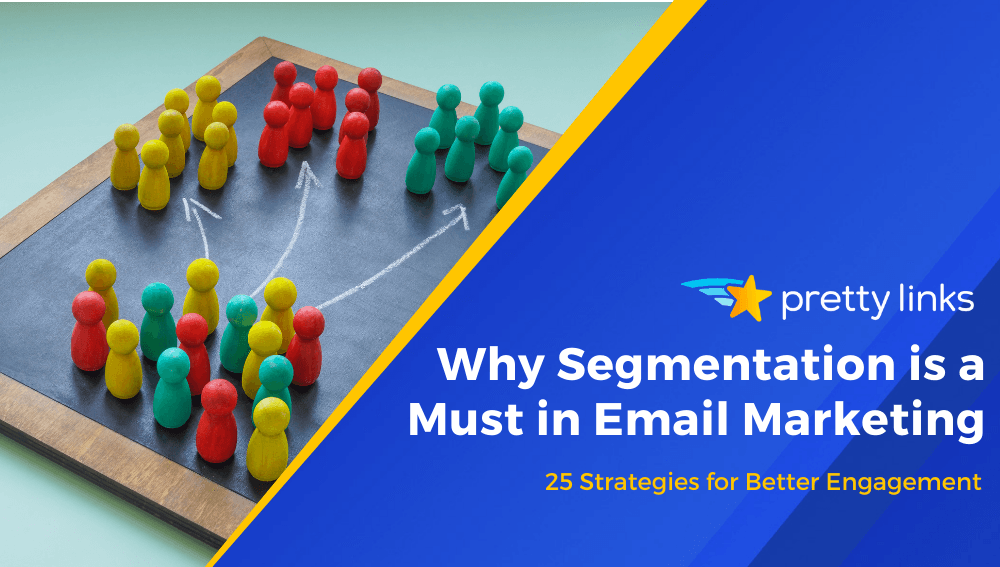




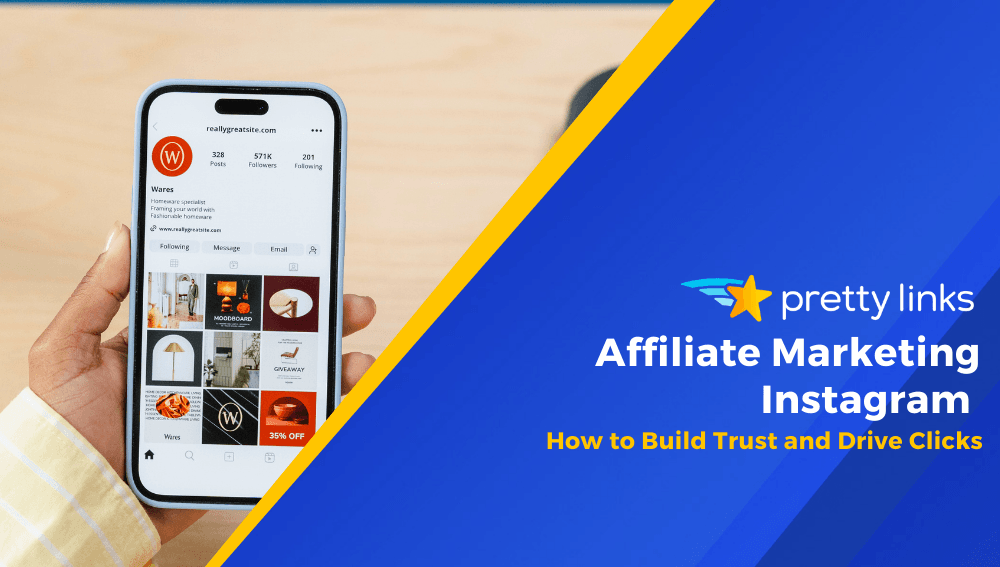
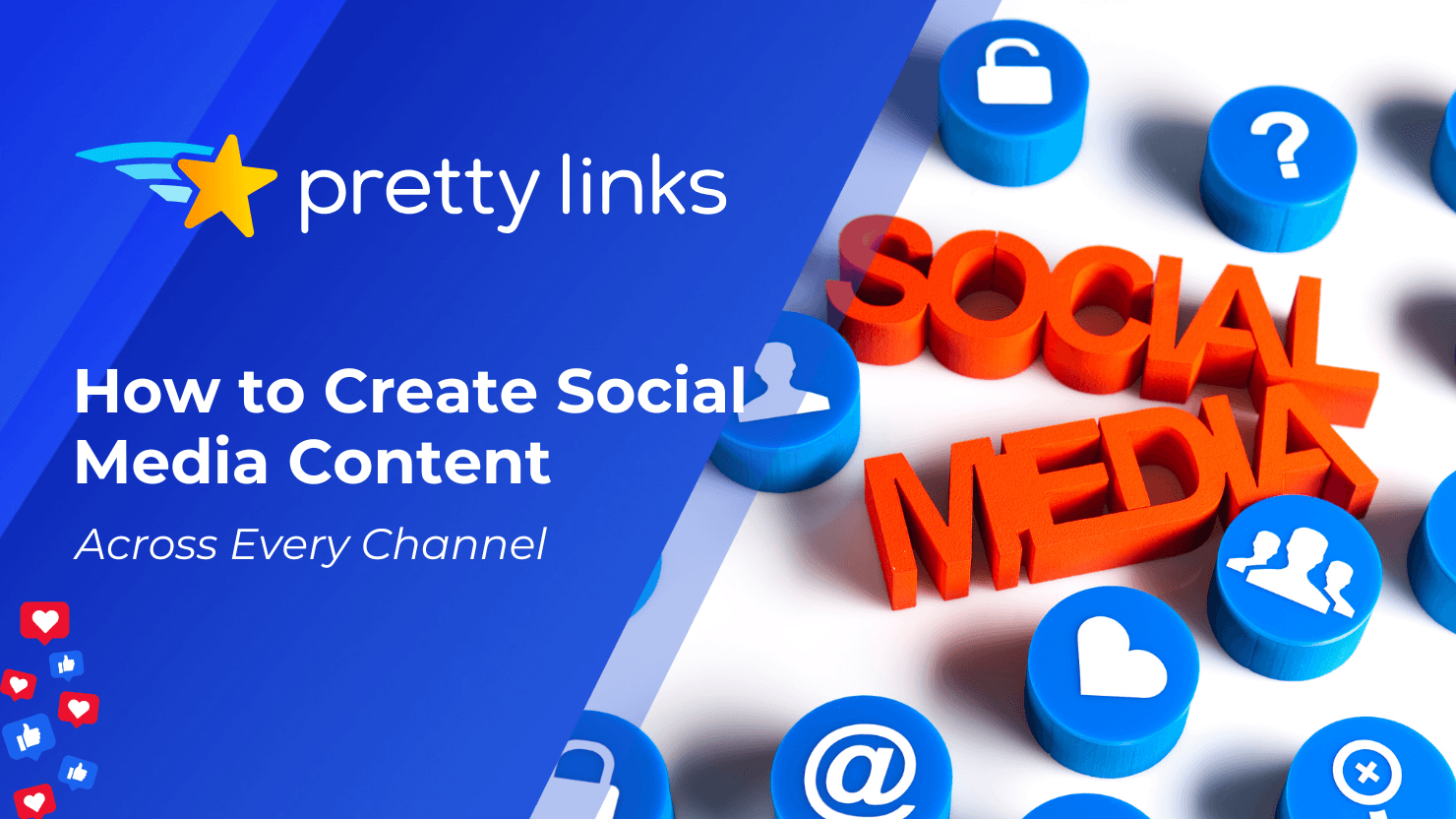
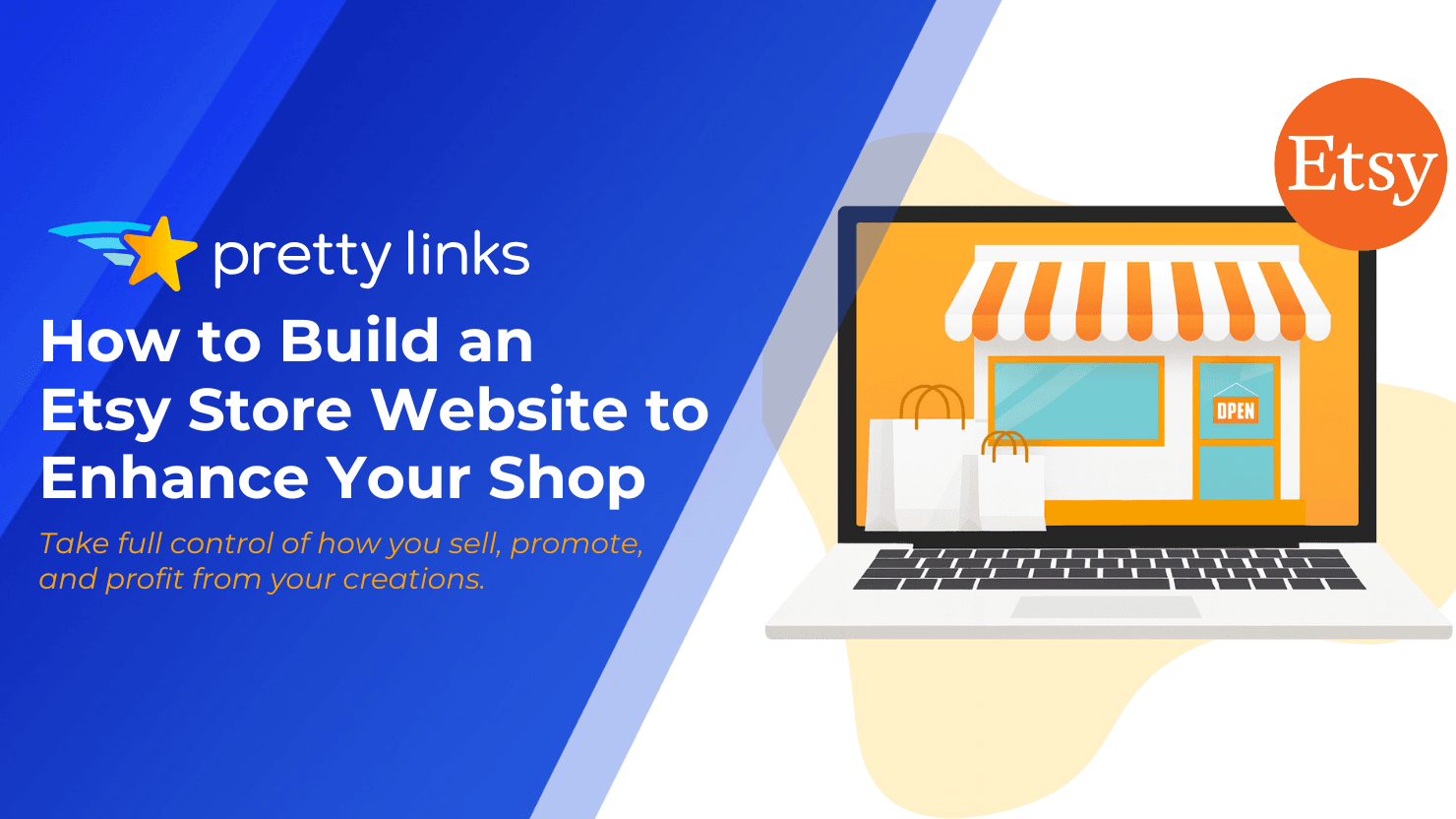
Deja una respuesta